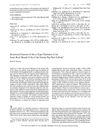TLDR Hair and nail cells share similar proteins, indicating a common differentiation pathway.
The study investigated the distribution and expression of various human hair proteins in the hair follicle using mouse monoclonal antibodies. It found that acidic 44K/46K and basic 56-60K keratins co-appeared in upper cortical and cuticle cells, while 10-25K high sulfur proteins were present only in matured cortical cells. Inner root sheath cells did not react with any antibodies, indicating immunological differences from cortex and cuticle filaments. Additionally, the nail plate contained 10-20% soft keratins along with hair keratins. These findings suggested that hair cortex and nail plate precursor cells share a differentiation pathway, with the 44K/46K and 56-60K keratins serving as markers for hair/nail-type epithelial differentiation.
81 citations
,
May 1986 in “Journal of Investigative Dermatology” 28 citations
,
October 1985 in “The Journal of Cell Biology” Researchers isolated and identified structural components of human hair follicles, providing a model for studying hair formation.
32 citations
,
October 1985 in “Annals of the New York Academy of Sciences” Keratin genes help explain how hair and feathers develop differently in mammals and birds.
12 citations
,
September 1982 in “Journal of Investigative Dermatology” 482 citations
,
June 1979 in “Proceedings of the National Academy of Sciences” Keratins provide structural strength in epithelial cells and help identify cell origins.
 24 citations
,
November 1978 in “Biochemistry”
24 citations
,
November 1978 in “Biochemistry” α-type filaments in guinea pig hair follicles have unique structural features.
25 citations
,
December 1973 in “Biochemical Journal” Guinea-pig hair and follicle proteins are mostly similar, but follicles have more group 2 proteins and fewer group 3 and 4 proteins.
23 citations
,
February 2004 in “British Journal of Dermatology” Keratin in mouse hair follicles is complex and plays specific roles.
45 citations
,
April 2001 in “The journal of investigative dermatology/Journal of investigative dermatology” Different Myc family proteins are located in various parts of the hair follicle and may affect stem cell behavior.
10 citations
,
October 2000 in “PubMed” E6/E7 oncogenes in hair follicles cause continuous hair growth by skipping the resting phase.
 94 citations
,
February 1994 in “The journal of investigative dermatology/Journal of investigative dermatology”
94 citations
,
February 1994 in “The journal of investigative dermatology/Journal of investigative dermatology” EGF makes hair follicles grow longer but stops hair production.
135 citations
,
November 1987 in “Differentiation” Outer root sheath cells consistently express certain keratins influenced by their environment.
59 citations
,
August 1981 in “PubMed” Trichilemmal keratinization is a unique process in hair follicles where the outer root sheath turns into keratin without a specific layer.


